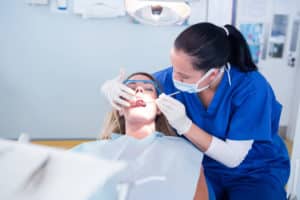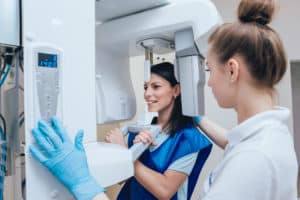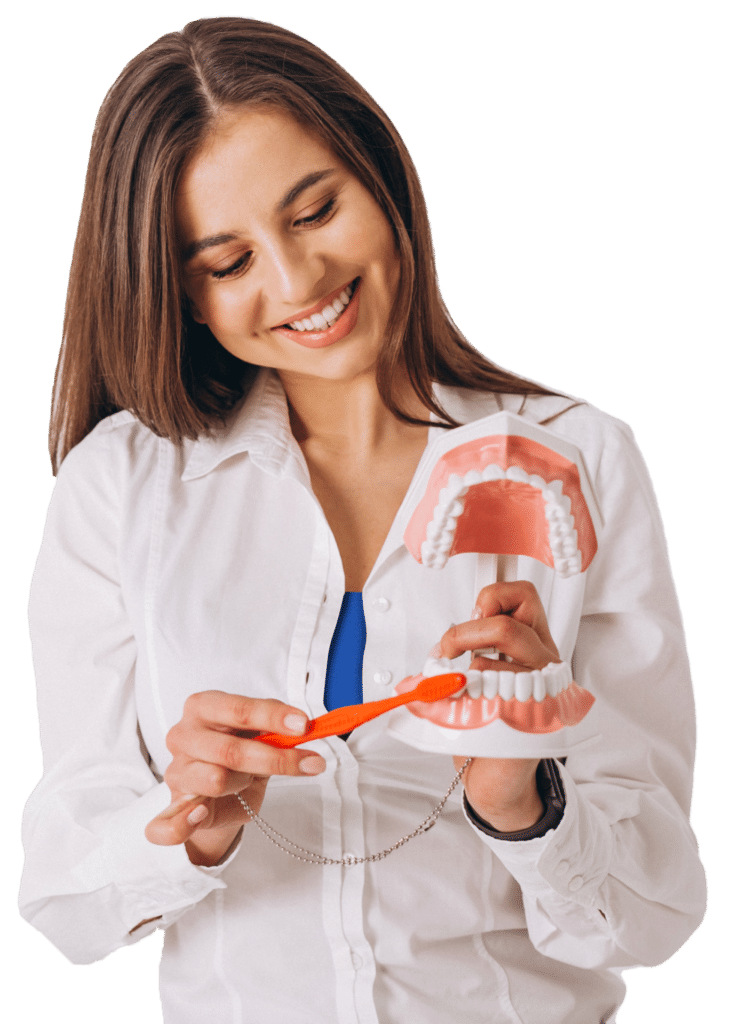
Entry Level Dental Assisting With Expanded Functions Radiology
Start Your New Career! BOOK A TOUR Flexible class schedule ALL-INCLUSIVE 90-DAY DENTAL ASSISTANT PROGRAM – OVERVIEW Our Florida Board of Dentistry approved Expanded Functions
The complete EFDA Dental Assisting program is 12-weeks.
Class options are single day and two-days per week.
Yes, call or chat with us about the different packages available.
Yes, with options of one and two-day classes per week, classes are held in daytime and evening hours. This provides the flexibility needed for even the busiest schedule.
Tuition includes all books and materials required to attend and complete the Dental Assisting program.
Yes, our number one goal is to ensure YOUR total success. We make all efforts to enable you the time to make-up course-work or testing that has not been completed or needs improvement.
We invite you to Meet the Team and discover the exciting world of Dentistry for free at one of our Dental Assisting with Friends Event.
Yes, we’re approved by the Board of Dentistry as well maintain an A+ record
64B5-16.002 Required Training.
(1) Formal training which is required for the performance of certain remediable tasks consists of a dental hygienist’s or dental assistant’s successful completion of an expanded duty course or program which meets one of the following requirements:
(a) The course or program is administered or was developed as a part of the regular curriculum at a school of dentistry, dental hygiene or dental assisting accredited by the American Dental Association’s Commission on Dental Accreditation, its successor agency or any other nationally recognized accrediting agency, or
(b) The course or program has been approved by the Board for the purpose of providing expanded-duties training for dental hygienists and dental assistants, or
(2) For the purpose of positioning and exposing radiographs by dental assistants, formal training may consist of having received certification as a dental radiographer pursuant to rule 64B5-9.011, F.A.C.
(3) The Board shall approve a course or program specified in paragraph 64B5-16.002(1)(b), F.A.C., in expanded duties only upon the application of the entity seeking to offer the course or program which establishes compliance with the following requirements. Failure to adhere to these requirements shall subject the course or program to revocation of Board approval.
(a) The course or program curriculum reflects appropriate didactic and clinical training in each remediable task which requires completion of Board-approved formal training and shall be designed to meet specifically stated educational objectives;
(b) Documentation of the training and experience of faculty members which establishes their qualifications to teach specified subject areas. Dentists and dental hygienists shall have a minimum of one year experience in expanded duty functions and expanded duty dental assistants shall have a minimum of 5 years of hands-on experience prior to approval. The student/teacher ratio shall not exceed one instructor to ten students. Applicants who have had a professional license revoked, suspended, or otherwise acted against, in Florida or in another jurisdiction, may be disqualified from participation as instructors;
(c) Submission of a detailed syllabus of the course or program which specifies the educational objectives for participants, the manner of achieving these specified objectives, including subject matter, hours of instruction and choice of instructional method (clinical or didactic) and the method of assessing a participant’s performance. Any course offered shall also include instruction regarding sterilization and disinfection procedures as stated in rule chapter 64B5-25, F.A.C., and instruction in the dental practice act and administrative code as it relates to dental auxiliaries.
(d) The course or program requires participants to pass clinical or written examinations which adequately test competency in each subject area. Participants must obtain a score of at least 75% out of a possible score of 100%. The choice of a clinical or written examination shall be based on the specified objectives for each subject area; and,
(e) Each participant who successfully completes the course or program is issued a certificate which contains the following information: name of course or program sponsor; title of course; date course offered; number of hours of instruction; participant’s name; signature authorized by the sponsor which attests to the certificate’s validity; and a list of all remediable tasks in which the participant has received formal training.
(f) Any clinical course in which patients are treated during instruction must be supervised by a dentist licensed pursuant to chapter 466, F.S.
(g) Facilities and equipment for each course in which patients are treated during instruction shall be adequate for the subject matter and method of instruction.
(4) On-the-job training required for the performance of certain remediable tasks consists of training in those tasks by a licensed dentist who assumes full responsibility for assuring that the dental hygienist or dental assistant has completed hands-on training in order that he/she is competent to perform the tasks.
Rulemaking Authority 466.004, 466.024 FS. Law Implemented 466.023, 466.024 FS. History–New 4-30-80, Amended 8-20-80, 1-28-81, 3-4-81, 4-20-81, Formerly 21G-16.02, Amended 6-30-86, 12-31-86, 7-5-87, 2-21-88, 7-12-88, 1-18-89, 11-16-89, Formerly 21G-16.002, 61F5-16.002, Amended 6-12-97, Formerly 59Q-16.002, Amended 1-29-07, 4-27-09, 11-16-11, 5-2-12.
64B5-16.005 Remediable Tasks Delegable to Dental Assistants.
(1) The following remediable tasks may be performed by a dental assistant who has received formal training and who performs the tasks under direct supervision:
(a) Placing or removing temporary restorations with non-mechanical hand instruments only;
(b) Polishing dental restorations of the teeth when not for the purpose of changing the existing contour of the tooth and only with the following instruments used with appropriate polishing materials – burnishers, slow-speed hand pieces, rubber cups, and bristle brushes;
(c) Polishing clinical crowns when not for the purpose of changing the existing contour of the tooth and only with the following instruments used with appropriate polishing materials – slow-speed hand pieces, rubber cups, bristle brushes and porte polishers;
(d) Removing excess cement from dental restorations and appliances with non-mechanical hand instruments only;
(e) Cementing temporary crowns and bridges with temporary cement;
(f) Monitor the administration of the nitrous-oxide oxygen making adjustments only during this administration and turning it off at the completion of the dental procedure;
(g) Selecting and pre-sizing orthodontic bands, including the selection of the proper size band for a tooth to be banded which does not include or involve any adapting, contouring, trimming or otherwise modifying the band material such that it would constitute fitting the band;
(h) Selecting and pre-sizing archwires prescribed by the patient’s dentist so long as the dentist makes all final adjustments to bend, arch form determination, and symmetry prior to final placement;
(i) Selecting prescribed extra-oral appliances by pre-selection or pre-measurement which does not include final fit adjustment;
(j) Preparing a tooth surface by applying conditioning agents for orthodontic appliances by conditioning or placing of sealant materials which does not include placing brackets;
(k) Using appropriate implements for preliminary charting of existing restorations and missing teeth and a visual assessment of existing oral conditions;
(l) Fabricating temporary crowns or bridges intra-orally which shall not include any adjustment of occlusion to the appliance or existing dentition; and,
(m) Packing and removing retraction cord, so long as it does not contain vasoactive chemicals and is used solely for restorative dental procedures;
(n) Removing and recementing properly contoured and fitting loose bands that are not permanently attached to any appliance.
(o) Inserting or removing dressings from alveolar sockets in post-operative osteitis when the patient is uncomfortable due to the loss of a dressing from an alveolar socket in a diagnosed case of post-operative osteitis;
(p) Making impressions for study casts which are being made for the purpose of fabricating orthodontic retainers;
(q) Taking of impressions for and delivery of at-home bleaching trays;
(r) Taking impressions for passive appliance, occlusal guards, space maintainers and protective mouth guards.
(2) The following remediable tasks may be performed by a dental assistant who has received formal training and who performs the tasks under indirect supervision:
(a) Making impressions for study casts which are not being made for the purpose of fabricating any intra-oral appliances, restorations or orthodontic appliances;
(b) Making impressions to be used for creating opposing models or the fabrication of bleaching stents and surgical stents to be used for the purpose of providing palatal coverage as well as impressions used for fabrication of topical fluoride trays for home application;
(c) Placing periodontal dressings;
(d) Removing periodontal or surgical dressings;
(e) Placing or removing rubber dams;
(f) Placing or removing matrices;
(g) Applying cavity liners, varnishes or bases;
(h) Applying topical fluorides which are approved by the American Dental Association or the Food and Drug Administration, including the use of fluoride varnishes; and,
(i) Positioning and exposing dental and carpal radiographic film and sensors;
(j) Applying sealants;
(k) Placing or removing prescribed pre-treatment separators;
(l) Securing or unsecuring an archwire by attaching or removing the fastening device; and,
(m) Removing sutures.
(3) The following remediable tasks may be performed by a dental assistant who has received on-the-job training and who performs the tasks under direct supervision:
(a) Applying topical anesthetics and anti-inflammatory agents which are not applied by aerosol or jet spray and;
(b) Changing of bleach pellets in the internal bleaching process of non-vital, endodontically treated teeth after the placement of a rubber dam. A dental assistant may not make initial access preparation.
(4) The following remediable tasks may be performed by a dental assistant who has received on-the-job training and who performs the tasks under indirect supervision:
(a) Retraction of lips, cheeks and tongue;
(b) Irrigation and evacuation of debris not to include endodontic irrigation;
(c) Placement and removal of cotton rolls; and,
(d) Taking and recording a patient’s blood pressure, pulse rate, respiration rate, case history and oral temperature.
(e) Removing excess cement from orthodontic appliances with non-mechanical hand instruments only.
(5) The following remediable tasks may be performed by a dental assistant who has received on-the-job training and who performs the tasks under general supervision:
(a) Instructing patients in oral hygiene care and supervising oral hygiene care.
(b) Provide educational programs, faculty or staff programs, and other educational services which do not involve diagnosis or treatment of dental conditions.
(c) Fabricating temporary crowns or bridges in a laboratory.
Rulemaking Authority 466.004(4), 466.024(3) FS. Law Implemented 466.024 FS. History–New 1-18-89, Amended 11-16-89, 3-25-90, 9-5-91, 2-1-93, Formerly 21G-16.005, Amended 3-30-94, Formerly 61F5-16.005, Amended 1-9-95, 9-27-95, 6-12-97, Formerly 59Q-16.005, Amended 1-8-01, 4-22-03, 7-13-05, 3-24-08.
The complete EFDA Dental Assisting program is 12-weeks.
Class options are single day and two-days per week.
Yes, call or chat with us about the different packages available.
Yes, with options of one and two-day classes per week, classes are held in daytime and evening hours. This provides the flexibility needed for even the busiest schedule.
Tuition includes all books and materials required to attend and complete the Dental Assisting program.
Yes, our number one goal is to ensure YOUR total success. We make all efforts to enable you the time to make-up course-work or testing that has not been completed or needs improvement.
We invite you to Meet the Team and discover the exciting world of Dentistry for free at one of our Dental Assisting with Friends Event.
Yes, we’re approved by the Board of Dentistry as well maintain an A+ record
64B5-16.002 Required Training.
(1) Formal training which is required for the performance of certain remediable tasks consists of a dental hygienist’s or dental assistant’s successful completion of an expanded duty course or program which meets one of the following requirements:
(a) The course or program is administered or was developed as a part of the regular curriculum at a school of dentistry, dental hygiene or dental assisting accredited by the American Dental Association’s Commission on Dental Accreditation, its successor agency or any other nationally recognized accrediting agency, or
(b) The course or program has been approved by the Board for the purpose of providing expanded-duties training for dental hygienists and dental assistants, or
(2) For the purpose of positioning and exposing radiographs by dental assistants, formal training may consist of having received certification as a dental radiographer pursuant to rule 64B5-9.011, F.A.C.
(3) The Board shall approve a course or program specified in paragraph 64B5-16.002(1)(b), F.A.C., in expanded duties only upon the application of the entity seeking to offer the course or program which establishes compliance with the following requirements. Failure to adhere to these requirements shall subject the course or program to revocation of Board approval.
(a) The course or program curriculum reflects appropriate didactic and clinical training in each remediable task which requires completion of Board-approved formal training and shall be designed to meet specifically stated educational objectives;
(b) Documentation of the training and experience of faculty members which establishes their qualifications to teach specified subject areas. Dentists and dental hygienists shall have a minimum of one year experience in expanded duty functions and expanded duty dental assistants shall have a minimum of 5 years of hands-on experience prior to approval. The student/teacher ratio shall not exceed one instructor to ten students. Applicants who have had a professional license revoked, suspended, or otherwise acted against, in Florida or in another jurisdiction, may be disqualified from participation as instructors;
(c) Submission of a detailed syllabus of the course or program which specifies the educational objectives for participants, the manner of achieving these specified objectives, including subject matter, hours of instruction and choice of instructional method (clinical or didactic) and the method of assessing a participant’s performance. Any course offered shall also include instruction regarding sterilization and disinfection procedures as stated in rule chapter 64B5-25, F.A.C., and instruction in the dental practice act and administrative code as it relates to dental auxiliaries.
(d) The course or program requires participants to pass clinical or written examinations which adequately test competency in each subject area. Participants must obtain a score of at least 75% out of a possible score of 100%. The choice of a clinical or written examination shall be based on the specified objectives for each subject area; and,
(e) Each participant who successfully completes the course or program is issued a certificate which contains the following information: name of course or program sponsor; title of course; date course offered; number of hours of instruction; participant’s name; signature authorized by the sponsor which attests to the certificate’s validity; and a list of all remediable tasks in which the participant has received formal training.
(f) Any clinical course in which patients are treated during instruction must be supervised by a dentist licensed pursuant to chapter 466, F.S.
(g) Facilities and equipment for each course in which patients are treated during instruction shall be adequate for the subject matter and method of instruction.
(4) On-the-job training required for the performance of certain remediable tasks consists of training in those tasks by a licensed dentist who assumes full responsibility for assuring that the dental hygienist or dental assistant has completed hands-on training in order that he/she is competent to perform the tasks.
Rulemaking Authority 466.004, 466.024 FS. Law Implemented 466.023, 466.024 FS. History–New 4-30-80, Amended 8-20-80, 1-28-81, 3-4-81, 4-20-81, Formerly 21G-16.02, Amended 6-30-86, 12-31-86, 7-5-87, 2-21-88, 7-12-88, 1-18-89, 11-16-89, Formerly 21G-16.002, 61F5-16.002, Amended 6-12-97, Formerly 59Q-16.002, Amended 1-29-07, 4-27-09, 11-16-11, 5-2-12.
64B5-16.005 Remediable Tasks Delegable to Dental Assistants.
(1) The following remediable tasks may be performed by a dental assistant who has received formal training and who performs the tasks under direct supervision:
(a) Placing or removing temporary restorations with non-mechanical hand instruments only;
(b) Polishing dental restorations of the teeth when not for the purpose of changing the existing contour of the tooth and only with the following instruments used with appropriate polishing materials – burnishers, slow-speed hand pieces, rubber cups, and bristle brushes;
(c) Polishing clinical crowns when not for the purpose of changing the existing contour of the tooth and only with the following instruments used with appropriate polishing materials – slow-speed hand pieces, rubber cups, bristle brushes and porte polishers;
(d) Removing excess cement from dental restorations and appliances with non-mechanical hand instruments only;
(e) Cementing temporary crowns and bridges with temporary cement;
(f) Monitor the administration of the nitrous-oxide oxygen making adjustments only during this administration and turning it off at the completion of the dental procedure;
(g) Selecting and pre-sizing orthodontic bands, including the selection of the proper size band for a tooth to be banded which does not include or involve any adapting, contouring, trimming or otherwise modifying the band material such that it would constitute fitting the band;
(h) Selecting and pre-sizing archwires prescribed by the patient’s dentist so long as the dentist makes all final adjustments to bend, arch form determination, and symmetry prior to final placement;
(i) Selecting prescribed extra-oral appliances by pre-selection or pre-measurement which does not include final fit adjustment;
(j) Preparing a tooth surface by applying conditioning agents for orthodontic appliances by conditioning or placing of sealant materials which does not include placing brackets;
(k) Using appropriate implements for preliminary charting of existing restorations and missing teeth and a visual assessment of existing oral conditions;
(l) Fabricating temporary crowns or bridges intra-orally which shall not include any adjustment of occlusion to the appliance or existing dentition; and,
(m) Packing and removing retraction cord, so long as it does not contain vasoactive chemicals and is used solely for restorative dental procedures;
(n) Removing and recementing properly contoured and fitting loose bands that are not permanently attached to any appliance.
(o) Inserting or removing dressings from alveolar sockets in post-operative osteitis when the patient is uncomfortable due to the loss of a dressing from an alveolar socket in a diagnosed case of post-operative osteitis;
(p) Making impressions for study casts which are being made for the purpose of fabricating orthodontic retainers;
(q) Taking of impressions for and delivery of at-home bleaching trays;
(r) Taking impressions for passive appliance, occlusal guards, space maintainers and protective mouth guards.
(2) The following remediable tasks may be performed by a dental assistant who has received formal training and who performs the tasks under indirect supervision:
(a) Making impressions for study casts which are not being made for the purpose of fabricating any intra-oral appliances, restorations or orthodontic appliances;
(b) Making impressions to be used for creating opposing models or the fabrication of bleaching stents and surgical stents to be used for the purpose of providing palatal coverage as well as impressions used for fabrication of topical fluoride trays for home application;
(c) Placing periodontal dressings;
(d) Removing periodontal or surgical dressings;
(e) Placing or removing rubber dams;
(f) Placing or removing matrices;
(g) Applying cavity liners, varnishes or bases;
(h) Applying topical fluorides which are approved by the American Dental Association or the Food and Drug Administration, including the use of fluoride varnishes; and,
(i) Positioning and exposing dental and carpal radiographic film and sensors;
(j) Applying sealants;
(k) Placing or removing prescribed pre-treatment separators;
(l) Securing or unsecuring an archwire by attaching or removing the fastening device; and,
(m) Removing sutures.
(3) The following remediable tasks may be performed by a dental assistant who has received on-the-job training and who performs the tasks under direct supervision:
(a) Applying topical anesthetics and anti-inflammatory agents which are not applied by aerosol or jet spray and;
(b) Changing of bleach pellets in the internal bleaching process of non-vital, endodontically treated teeth after the placement of a rubber dam. A dental assistant may not make initial access preparation.
(4) The following remediable tasks may be performed by a dental assistant who has received on-the-job training and who performs the tasks under indirect supervision:
(a) Retraction of lips, cheeks and tongue;
(b) Irrigation and evacuation of debris not to include endodontic irrigation;
(c) Placement and removal of cotton rolls; and,
(d) Taking and recording a patient’s blood pressure, pulse rate, respiration rate, case history and oral temperature.
(e) Removing excess cement from orthodontic appliances with non-mechanical hand instruments only.
(5) The following remediable tasks may be performed by a dental assistant who has received on-the-job training and who performs the tasks under general supervision:
(a) Instructing patients in oral hygiene care and supervising oral hygiene care.
(b) Provide educational programs, faculty or staff programs, and other educational services which do not involve diagnosis or treatment of dental conditions.
(c) Fabricating temporary crowns or bridges in a laboratory.
Rulemaking Authority 466.004(4), 466.024(3) FS. Law Implemented 466.024 FS. History–New 1-18-89, Amended 11-16-89, 3-25-90, 9-5-91, 2-1-93, Formerly 21G-16.005, Amended 3-30-94, Formerly 61F5-16.005, Amended 1-9-95, 9-27-95, 6-12-97, Formerly 59Q-16.005, Amended 1-8-01, 4-22-03, 7-13-05, 3-24-08.

Start Your New Career! BOOK A TOUR Flexible class schedule ALL-INCLUSIVE 90-DAY DENTAL ASSISTANT PROGRAM – OVERVIEW Our Florida Board of Dentistry approved Expanded Functions

FLORIDA DENTAL RADIOGRAPHY COURSE GUIDELINES In order to work with dental radiography privileges, dental assistants in Florida must complete specific training courses approved by the

90-DAY EXPANDED FUNCTIONS DENTAL ASSISTANT PROGRAM – OVERVIEW The Expanded Functions Dental Assisting program is a specialized 90-Day Hands-On Training course designed to fast-track
Are you Ready to join the Exciting and rewarding world of Dentistry?
Then take the next step and set a time to Meet YOUR Team!
